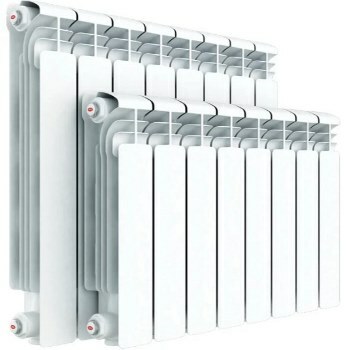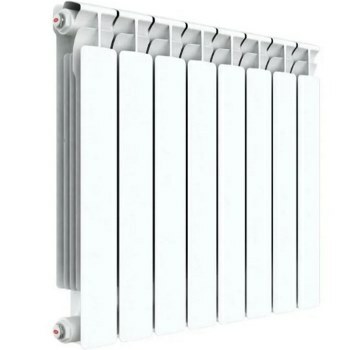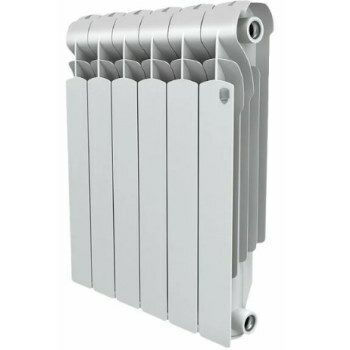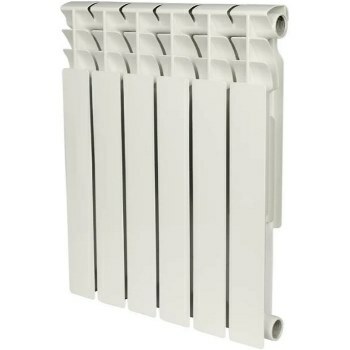Radiators are the central link of the heating system. Ultimately, it depends on what material they are made of whether your home will be warm in cold weather. Let's compare the consumer properties of popular aluminum and bimetallic radiators, and take a closer look at the four best models.
CONTENT
- 1 Features of aluminum radiators
- 2 Pros and cons of bimetallic radiators
- 3 Comparison of bimetallic and aluminum radiators
- 4 The best bimetallic and aluminum radiators
- 5 FAQ
Features of aluminum radiators
Aluminum is a lightweight metal with high thermal conductivity, which is excellent for the manufacture of radiators. Aluminum radiators are different:
- compactness and low weight;
- reasonable price;
- fast heating.
At the same time, aluminum is inferior in strength to steel and readily enters into chemical reactions with substances contained in the coolant. Therefore, aluminum radiators have their own disadvantages:
- small margin of safety;
- exactingness to water quality;
- rapid cooling.
In general, for a private house, in the heating system of which we ourselves regulate the pressure and water quality, aluminum batteries will feel great. But in the apartment of a multi-storey building, problems may begin.
Pros and cons of bimetallic radiators
Bimetallic radiators are made from a combination of two metals. Usually, aluminum fins are placed on a steel pipe, which allows achieving high strength while maintaining sufficient heat transfer. Bimetallic radiators are characterized by:
- high strength and reliability;
- long service life;
- undemanding to water quality.
The disadvantages of bimetallic radiators include:
- high price;
- great weight.
Bimetallic radiators will feel best in an ordinary apartment, because they do not care about water shocks or low-quality coolant.
Comparison of bimetallic and aluminum radiators
Heat dissipation. Steel has less thermal conductivity and heat transfer than aluminum, but its thermal inertia is higher. Therefore, purely aluminum radiators heat up faster and give off heat better. However, they cool faster, while the steel will continue to give off the accumulated heat for some time even if the supply of the hot coolant suddenly stops.
Maximum pressure. Aluminum pipes are more sensitive to pressure drops than steel pipes. Aluminum radiators can rarely withstand pressures above 20 atmospheres, while bimetallic and 40 atmospheres are often not the limit. Therefore, in the central heating system, where pressure surges and natural water shocks are not uncommon, bimetallic batteries feel much better. At the same time, aluminum radiators are suitable for a private house, where the pressure in the system will never rise above 10 atmospheres.
Maximum working temperature. Here, the victory remains with bimetal: steel pipes can withstand operating temperatures up to 130 degrees, and aluminum usually only up to 110. But each category has its own exceptions.
Water quality. Aluminum is very sensitive to acids and alkalis in water. Therefore, a long service life of aluminum radiators in a central heating system, through which a heat carrier with an unknown pH circulates, cannot be expected. Steel takes this problem much more calmly, but tends to rust.
Reliability and service life. Typically, the service life of bimetallic radiators is up to 20 years, while aluminum ones are twice as low. But here a lot depends on the quality of the batteries and the operating conditions.
Weight. Bimetallic radiators are heavier than aluminum ones. Not too much, but there really is a slight difference: a 6-7-section bimetallic radiator will be almost a kilogram heavier than its aluminum counterpart.
Price. Aluminum radiators are 20 percent cheaper than bimetallic counterparts.
The best bimetallic and aluminum radiators
1. Radiator aluminum Rifar Alum Ventil 500 x14

Sectional aluminum radiator with 14 elements. Designed for wall mounting. Bottom connection for standard ½ ”pipe. The heat dissipation of the radiator is 2562 W, which is enough to heat a room up to 25.6 m². The maximum operating temperature is 135 degrees, the operating pressure is 20 bar, the pressure test is 30 bar. The radiator comes with a mounting kit for self-installation. According to its parameters, this radiator is suitable even for installation in an apartment building, however, its price is very serious - more than 10,000 rubles.
Price: ₽ 10 220
Rifar Alum Ventil 500 x14
2. Bimetallic radiator Rifar Alp Ventil 500 x6

Wall mounted 6-section bimetallic radiator. Bottom connection accepts ¾ ”pipe. The heat dissipation of the radiator is 612 W, which is enough to heat a small room up to 6 square meters. The maximum operating temperature of the heating medium is 135 degrees, the maximum operating pressure can reach 20 bar, and the pressure test is 30 bar. They ask for a little more than 5500 rubles for this radiator, which, given the high reliability and efficiency of the battery, looks like a quite reasonable price.
Price: ₽ 5 520
Rifar Alp Ventil 500 x6
3. Radiator aluminum Royal Thermo Indigo 500 x6

For this purely aluminum radiator for 6 sections, they ask for less than 4000 rubles, but its high efficiency pays for this price in full. The battery is designed for wall mounting and is equipped with a side wiring. The heat dissipation of the radiator is an impressive 748.8 W for such a compact model, which allows heating an area of almost 7.5 square meters. The maximum working temperature does not exceed 110 degrees, but the maximum working pressure reaches 20, and the pressure test - 30 bar. Nice product for a small room in a private house.
Price: ₽ 3 930
Royal Thermo Indigo 500 x6
4. Bimetallic radiator ROMMER Optima Bm 500 x6

The most budgetary radiator model in our selection. The price for this device starts from about 2300 rubles, but this does not mean that the battery can be called bad. There are 6 sections, wall construction, side connection. The operating temperature is 110 degrees, and the maximum power is 774 W, which is enough to heat almost 8 square meters in a room with not too high ceilings and good thermal insulation. The maximum working pressure is 18 bar and the pressure test is 30 bar. An excellent inexpensive option for any occasion.
Price: ₽ 2 369
ROMMER Optima Bm 500 x6
FAQ
Which radiators have a longer service life?
There are many variable factors, so this question cannot be answered unequivocally. The service life of a radiator depends on the quality of the product itself, on the hardness and contamination of the water, on the stability of the pressure in the system and other parameters. Nevertheless, all other things being equal, a bimetallic radiator will most likely last longer than an aluminum one: the service life of the former reaches 20 years, and of the latter, about 10.
How to distinguish a bimetallic radiator from an aluminum one?
There are several ways:
- a bimetallic radiator is about a pound heavier than an aluminum one, so you can compare the weight of a battery that contains doubts, with the weight of the control sample (a 6-section aluminum radiator will be lighter than the same bimetallic one by almost kilogram);
- at the place where the thread for connecting pipes is located at the bimetallic radiator, you can see the border between steel and aluminum - a monometallic battery does not have such a border;
- the steel pipe in the bimetallic radiator is magnetic, so you can simply bring a magnet to the battery - it will not be attracted to pure aluminum.

